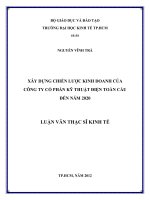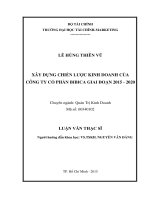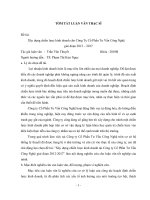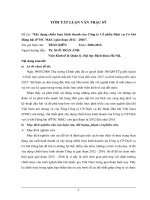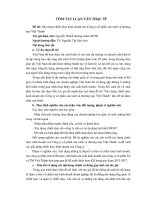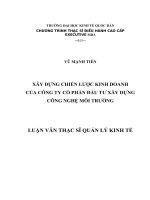Luận văn thạc sĩ xây dựng chiến lược kinh doanh của công ty cổ phần PVFC chi nhánh thăng long
Bạn đang xem bản rút gọn của tài liệu. Xem và tải ngay bản đầy đủ của tài liệu tại đây (655.86 KB, 83 trang )
LUẬN VĂN THẠC SĨ
Xây dựng chiến lược kinh doanh của công ty cổ phần PVFC chi nhánh Thăng Long
THESIS MBA
BUILDING BUSINESS STRATEGIES OF PETROVIETNAM
JOINT STOCK FINANCE CORPORATION- THANG LONG
BRANCH, PERIOD 2010-2015 AND ORIENTATION TO 2020
1.
COMMITMENT
We would like to commit that the content of research paper has not been
submitted to any advanced program as well as any training program.
We also pledge that this research paper is the effort of members in the group.
The results, analyses and conclusions in this research paper (except for quoted parts)
are the work achievements of the whole group.
SIGNATURE OF STUDENTS
ACKNOWLEDGEMENT
TABLE OF CONTENTS
INTRODUCTION ..........................................................................................................1
1. The subject...............................................................................................................1
2. Reasons for choosing the subject
...........................................................1
3. Purpose of research..................................................................................................1
4. Scope of research ....................................................................................................2
5. Methods of implementing research ........................................................................2
6. Questions of research .............................................................................................2
7. Implications of the subject......................................................................................2
8. The limitations of the subject .................................................................................3
9. Expected result .......................................................................................................3
10. Structure of the subject..........................................................................................3
CHAPTER 1- RATIONALE..........................................................................................4
1.1. STRATEGY AND BUSINESS STRATEGY .................................................4
1.1.1. Strategy ........................................................................................................4
1.1.2. Business strategy and the selection of business strategy..............................5
1.1.3. The implication and role of business strategies............................................5
1.2. STRATEGY-FORMING PROCESS...................................................................6
1.2.1. Mission and vision ........................................................................................7
1.2.2. Strategic targets .........................................................................................8
1.2.3. Analyzing outside environment ....................................................................9
1.2.3.1 Analyzing micro-environment...............................................................10
1.2.3.2 Analyzing micro-environment (sectorial environment)........................14
1.2.4. Analyzing internal environment .................................................................16
1.2.4.1 Analyzing based on the field of doing business – Value Chain...........17
1.2.4.2 The process of identifying steady competitive advantages...................19
1.2.5. SWOT matrix...............................................................................................20
1.2.5.1 General theory of SWOT.......................................................................20
1.2.5.2. SWOT matrix........................................................................................20
1.2.6. Selecting strategies......................................................................................21
1.2.6.1 Strategy of cost leading..........................................................................22
1.2.6.2 The strategy of making products unique...............................................23
1.2.6.3 The strategy of focusing on key things.................................................23
1.2.6.4 The combination of those strategies......................................................25
The summary of Chapter I.........................................................................................25
CHAPTER 2- BUILDING AND SELECTING BUSINESS STRATEGIES OF PVFC
THANG LONG ............................................................................................................27
2.1. AN OVERVIEW OF PVFC...............................................................................27
2.1.1. Formation and development process ..........................................................27
2.1.2. Types of products .......................................................................................27
2.1.3. Norms of business activities ....................................................................28
2.1.4. Development orientation to 2015 and vision to 2020-2025.......................29
2.2. Overview of Thang Long branch of Petrol Vietnam Finance Corporation......30
2.2.1. The establishment and development process..............................................30
2.2.2. Organizational structure..............................................................................30
2.2.3. The targets of the main business activities. ...............................................32
2.3. BUILDING AND SELECTING BUSINESS STRATEGIES FOR PVFC
THANG LONG IN THE PERIOD 2010 - 2015.......................................................33
2.3.1. Outside environment analysis.....................................................................33
2.3.1.1. Macro environment analysis – PEST Model........................................33
2.3.1.2. Inside- industry environment analysis- the M. Porter’s five forces
model..................................................................................................................38
2.3.1.3. The summary of outside environment analysis result..........................45
2.3.2. Internal Environment Analysis – Value Chain Model................................51
2.3.2.1. Value Chain Model...............................................................................52
2.3.2.2. Identifying outstanding ability and sustainable competitive advantage
............................................................................................................................56
2.3.2.3. Synthesizing results of internal environment analysis.........................58
2.3.3. Matrix Analysis: SWOT..............................................................................59
Summary of Chapter 2...............................................................................................61
CHAPTER 3 – SELECTED STRATEGIES AND IMPLEMENTATION
MEASURES FOR SELECTED STRATEGIES..........................................................62
3.1. DEVELOPING TARGET FOR PVFC TO 2015, ORIENTED TO 2025........62
3.2. PVFC THANG LONG DEVELOPMENT ORIENTATION UNTIL 2015.....64
3.3. SELECTING BUSINESS STRATEGIES.........................................................65
3.3.1. General strategies.........................................................................................65
3.3.2. Selecting application strategies...................................................................66
3.4. PVFC THANG LONG’S SELECTED STRATEGIES.....................................67
3.5. IMPLEMENTATION MEASURES..................................................................69
3.5.1 Implementation measures for strategy 1 – Focal point strategy..................69
3.5.2 Implementation measures for strategy 2- Distinction strategy....................70
3.5.3 Measures for making breakthroughs............................................................71
3.6. SUGGESTIONS ON SUPPORTING MEASURES.........................................72
3.7. SHORTCOMINGS OF THE CAPSTONE PROJECT REPORT AND
ORIENTATION FOR FURTHER RESEARCH.....................................................74
3.8. CONCLUSION..................................................................................................75
GENERAL CONCLUSION OF THE CAPSTONE PROJECT REPORT.................76
REFERENCES
......................................................................................................77
LIST OF ABBREVIATIONS
Abbreviations
GDP
PEST
Content
PV
PVFC
PVFC Thang
Gross domestic product
Political- Economic- Social- Technological Model
PetroVietnam (Vietnam Oil and Gas Group)
PetroVietnam Joint Stock Finance Corporation
PetroVietnam Joint Stock Finance Corporation – Thang Long
Long
SO
Branch
Competitive Strategies combining Strengths and Weaknesses of
ST
Company (Strengths-Opportunities)
Competitive Strategies combining Strengths and Threats of
SWOT
Company (Strengths-Threats)
Strengths- Weaknesses- Opportunities- Threats Matrix of
TCTD
TNHH
VDL
WO
Company (Strengths - Weaknesses - Opportunities - Threats)
Credit Institution
Limited
Charted Capital
Competitive
Strategies
combining
Weaknesses
and
WT
Opportunities of Company (Weaknesses-Opportunities)
Competitive Strategies combining Weaknesses and threats of
Company. (Weaknesses -Threats)
LIST OF TABLES
INTRODUCTION
1. The subject
Building strategies of PetroVietnam Finance Corporation – Thang Long Branch
(PVFC Thang Long) period 2010-2015 and orientation to 2020
2. Reasons for choosing the subject
In any enterprise, the designing of operation strategies is aiming at orienting the
enterprise to get the soundest step to adjust its operation. In the mechanism of the
market economy, the formation of a suitable business strategy has an especially
significant implication; it helps the enterprise soon achieve business development goals.
The effective implementation of business policies and strategies will help the enterprise
develop sustainable.
The PetroVietnam Joint Stock Finance Corporation- Thang Long Branch is one of
nine branches under PetroVietnam Finance Corporation. It has come into being and
operated since August 2007 and operates in the fields of finance and currency.
Although the Company has had business strategies and implemented them already; yet,
they are only strategies in the initial steps and still have a lot of shortcomings and have
not been built methodically. Besides, financial and monetary operation is a relatively
sensitive field; thus, the formation of a proper strategy in this period is badly needed
and important to orient for the business strategies of PVFC Thang Long develop
sustainable.
To be prompted by that reality, we have chosen the subject “Building strategies
of PetroVietnam Joint Stock Finance Corporation-Thang Long Branch period 20102015 and orientation to 2020”.
3. Purpose of research
The subject systematically collects the theoretical bases on business strategies to
serve the research and building business strategies for the company. Analyzing the
impact of business environment on financial trading activities. Well recognizing the
opportunities and challenges, strengths and weaknesses of the enterprise.
1
From that, we have mapped out the measures on necessary business strategies to
enhance the effectiveness of specific business strategies for PVC Thang Long.
4. Scope of research
In the scope of this research, the authors only concentrate on studying, building
and selecting business strategies to apply in the period from 2010-2015.
5. Methods of implementing research
The subject uses following methods:
-
Comparing, analyzing and generalizing: analyzing the data, comparing over
periods then generalizing to give comment.
-
Analyzing SWOT matrix: the technique is used to analyze and process the
research’s result on environment, helping the enterprise formulate a strategy
scientifically, etc.
-
Statistical method: collecting statistics from tables and charts and drawing
out conclusion of trends to evaluate the operation situation of the sector and
the enterprise.
6. Questions of research
- Why does the Company need to have business strategies?
- If there are, what are suitable business strategies for the Company?
- How to make selected business strategies take effect?
7. Implications of the subject
The subject has systematized the rationale on building business strategies and
applied to formulate business strategies for PVFC Thang Long.
The subject analyzes the operation situation of PVFC and PVFC Thang Long and
selects the appropriate business strategies for the Unit in the time to come.
The subject has put forward the measures to implement the selected business
strategies for PVFC Thang Long.
Being the reference document for current branches and branches which will be
opened in the upcoming time in the system of PVFC and other Finance Corporations.
2
8. The limitations of the subject
The duration of research and the source of statistics for the research are limited. The
world’s as well as Vietnam’s economy has a lot of unprecedented fluctuations causing
great impact on the financial and monetary market of Vietnam which results in the fact that
the building of strategies is sometimes not close to the real situation sometimes.
9. Expected result
- Selecting and building suitable business strategies for PVFC Thang Long.
- Setting the oriented base for the business and development process of the
Company in the period from 2010-2015 and the vision till 2020.
10. Structure of the subject
Apart from the introduction, appendix and associated tables, the structure of the
subject consists of three chapters:
Chapter 1: Rationale.
Chapter 2: Building business strategies for PetroVietnam Joint Stock Finance
Corporation- Thang Long Branch.
Chapter 3: The measures to implement the selected strategies.
3
CHAPTER 1- RATIONALE
1.1. STRATEGY AND BUSINESS STRATEGY
1.1.1. Strategy
The term “strategy” originated from military sector with the meaning “the science
on planning and controlling military activities”, “the art to give command on means to
defeat the opponents”. Starting from military sector, the term strategy is used much in
business field in both macro and micro scale: socio-economic development strategy,
mechanical and chemical industry development strategy; strategy to develop the
corporation and the company with the content to define the fundamental long-term
targets, action and resource allocation plans to exercise the target of the economy, the
sector and the enterprise in the long run.
Coming into being since the 1960s of 20 th century, strategy and business strategy
have been applied in many enterprises with different conceptions.
James B Quinn thought that “strategy is a model or a plan to coordinate the main
targets, policies and action process into an ensemble”.
William J Glueck viewed “strategy is a uniformed, comprehensive and
coordinative plan, designed to ensure that the basic targets of the enterprise will be
exercised”.
Alfred Chandler, Harvard University defined, “strategy embraces the fixation of
fundamental and long-term goals of the enterprise, at the same time selecting the
method or action process and allocation of essential resources to realize those goals”.
In short, strategies of an enterprise have three following most common features:
- Forming a general action plan toward the future on the basically long-term
business goals of the enterprise;
- Any changes of important policies and measures of the enterprises are made by
the decision of the enterprise’s owner;
- Setting up the order of action, implementing and resource allocating method to
realize the goals of the enterprise.
4
1.1.2. Business strategy and the selection of business strategy
Definition of business strategy: is the orientation of business activities having
targets in the long run in parallel with the systems of policies, measures and resource
allocation to realize the goals of the enterprise in the same period.
Business strategy of an enterprise is a general action program aiming at realizing
the enterprise’s goals. Business strategy only creates a framework to guide the thought
on the orientation to do business and to act.
As collected, business strategies can be classified into three groups:
- Group1: Regarding business strategy as an art, for example the art to generate
business advantages;
- Group 2: Considering business strategy as a special kind of plan, for example,
Some definitions like “business strategy is the route and the mean to reach the
goal” or “business strategy is to determine the long-term goals”, etc;
- Group 3: Viewing business strategy both as an art and kind of program to
realize strategic and long-term goals. It is the ensemble of policies, programs,
projects and plans.
.
From the above-mentioned definitions, we can see that their common feature is
business strategy of an enterprise needs to have target orientation, long-term character,
initiative thought and needs to be implemented in a systematically calculated process.
1.1.3. The implication and role of business strategies
Business strategies have become increasingly important to the existence and
development of enterprises, a tool helping the enterprises’ development orientation
according to the set targets and in line with the objective conditions of business
environment.
- Having business strategies will help enterprises clearly see their objectives and
orientations. Then, enterprises will find out how to organize its business apparatus?
What they need to do to attain success in doing business and know when their
enterprises will reach the set targets;
- In the fast changing business environment, a lot of opportunities for seeking
profit have been created but associated with a great number of traps and risks. Having
5
business strategies will help enterprises actively take the most advantage of new
business opportunities at the same time reduce risks on the market;
- Thank to applying business strategies, enterprises will match their made
decisions with conditions of the environment, helping balance between enterprise’s
resources and objectives on one side and market opportunities on the other side to
ensure the good implementation of the set targets:
- In the tough competitive environment, analyzing the elements of macro
environment and operational environment comprehensively and adequately will help
enterprise define its rivals and on that basis, it will work out an overall solution to
enhance its competitive capacity on the market.
The basic roles and implications of business strategies have affirmed the
objective necessity of strategies in administrative activities in general and business
administrative activities in particular in a modern economy. Therefore, the approaching
and applying strategies is a very crucial issue at present.
1.2. STRATEGY-FORMING PROCESS
The master business strategy is developed basing on the vision of the enterprise
and bears the orientation for all the activities in the enterprise and has long-term
strategic character. The process of formation includes following steps: Building,
Mission and Vision Statements.
6
Table 1-1: Process of building business strategies
Vision/Mission
1.2.1. Mission and vision
a)Analyzing
Mission
Analyzing
inside
Building and selecting
environment
environment
Mission is a concept referringstrategies
to the highest purpose, the meaning of coming
Model of value chain
1. Macro-analysis
SWOT, GREAT model
into
being,
existing
and
developing
of
an
enterprise.
It
is
a
statement
view to
PEST/SLEPT model
Process with
of the
realizing
2. Micro-analysis
sustainable competitive
the usefulness of the enterprise toward the society. The enterprise’s
statement of
Mc. Porter model
edges
=> Competitive
mission
needs topressure
ensure these following
Funtionalrequirements:
Strategies
in the sector
- Ensuringand
the concord in enterprise;
=> Strong & weak
=> Opportunities
challenges
Business/competitive
- Creating conditions to mobilize
resources of the enterprise;
outside
Strategies
- Establishing favorable setting and
atmosphere for business activities in the
Supervising and
evaluating the
Suitable
Organizational
- Being
the centre to orient the concord and effort of members
in the enterprise;
implementation
of the
Chiến lược toàn cầu
structure to the selected
Implementing and
strategy
- Set out the conditions to
concretize
the targets, building strategies and
strategies
adjusting
strategies
thực thi chiến lược
enterprise;
Company’s Strategies
measures for implementing;
Generally, mission of enterprise is determined right when the enterprise is established;
it exists during administrative process and it can be adjusted and changed in parallel
with the changes in functions and tasks of the enterprise.
A mission of an enterprise often includes 9 components, namely:
- Customers;
- Products and services;
- Market;
- Technology;
- The interest in the existence, development and interest-generating capacity;
- Business philosophy;
- Self evaluation;
- The enterprise’s concern about the community;
- The enterprise’s concern about employees in the enterprise.
7
The mission of the enterprise is valuable during the enterprise’s operation
process if there are no changes or adjustments. However, in each stage, that strategy
needs to be concretized into strategic targets that suit each of those stages.
b) Vision
A declaration of vision is a report about the position that the company wants to
reach. The statement of vision drafts the future of the company about its target and
purpose. The declarations of vision need to identify the final destination the enterprise
needs to attain.
Vision is the need-to-be-achieved target of the enterprise and needs to be
satisfied some following factors:
- The time that the enterprise aims at and reaches the target;
- Locating the scale and stature of the enterprise in the business community and
society;
- Setting the vision toward the highest product quality with the cheapest price;
- The enterprise needs to aim at the benefit of consumers.
Vision statement is a message which concretize the mission statement into an
encouraging target, mentions the necessity of vital improvement to the enterprise. It
creates the confidence in the future of the enterprise and aims at the target to make
impossible things into possible ones.
1.2.2. Strategic targets
Strategic targets are the milestone, the states which the enterprise wants to reach
in strategic stages. The determination of strategic targets has a significant meaning to
the enterprise.
The targets of enterprise might be very diverse and can be classified by different
criteria:
-
In the aspect of time: there might be long-term, medium-term and short-term
targets;
-
With regard to the essence of the target: there might be economic, political or
social targets;
-
In term of level: including the targets at the levels of enterprise, business unit
or functional level;
8
-
With regard to form of targets: there might be oriented or quantitative
targets;
-
With respect to the quality of growth: including such kinds of targets as
increasing or sustaining the stability of market share or even decreasing. The
highest target of the enterprise is the sustainable development in the market.
However, it might have different specific levels depending on different
conditions. Author Peter Drucker proposed a system of enterprise’s targets
from short-term to long-term, as follows:
- Market share of the enterprise;
- Profit;
- Allocation of resources and risks;
- Labor productivity;
- Competitive position;
- Development of human resource;
- Social response.
The strategic target must be limited in the corresponding tie to the environment
and capacity of the enterprise as a whole. A good target must possess both advancement
and feasibility. To ensure that requirement, the determination of strategic needs to be
based on the following factors:
- Overall business tasks of the enterprise and those in specifically strategic stages;
- Business philosophy (is represented in mission statement of the enterprise);
- General judgment on business environment and capacity of the enterprise.
1.2.3. Analyzing outside environment
The target of analyzing outside environment is to define opportunities and
challenges to the enterprise, analyzing to find out the way to deploy and grasp
opportunities from the environment and to avoid necessary challenges to the enterprise.
The scope is the content of analyzing environment including: analyzing macroenvironment (general environment) and analyzing micro-environment or sectorial
environment.
9
1.2.3.1 Analyzing micro-environment
The analysis of micro-environment will help the enterprise answer the question:
What is the enterprise faced with?
Micro-environment is the environment in the scope of the whole economy,
consisting of six segments: economics, technology, culture, society, demography,
politics, law and globe. The changes in micro-environment might have direct impact on
any forces in the sector; thus, it can relatively influence other forces and on itself,
finally, changing the attraction of a branch.
Table 1-2: Three-level analysis model of external and internal environment
Populatio
n
Labor
Culture
Society
Xã hội
Econo
mics
tế
Suppliers
Potential
competitors
Tiềm
năng
Com
pany
Competitiv
e rivals
Tech
nolog
y
Custom
ers
hàng
Alternative
product
thay thế
International
environment
10
Politics
Laws
(Sources: Strategic Management - Griggs University)
a) Political- Legal environment (P)
This environment includes State’s policies, system of laws, especially those
relating to business field; domestic and International affairs, factors concerning politics
and laws consist of:
-
The stability of politics and foreign policy;
-
The balance in the Government’s policies;
-
The roles M«i
and treconomic development strategies of the Party and the
tÕ life;
Government to the fieldsQuèc
of social
-
The regulation and trend of intervention into economic activities of the
C«ng nghÖ
Government;
-
The improvement of law system and the executive effect of them in the
economy.
b) Economic environment (E)
This element has direct and strong impact on business activities of enterprise
through the fluctuation of macro-economic variables as well as the influence of macro
economic policies via adjustment tools of the State; these factors needing consideration
here are:
(1) The trend and GNP growth rate (or GDP);
(2) The situation of inflation and fluctuation of prices;
(3) Balance of payment;
(4) Interest and the trend of interest;
(5) Exchange rate and fluctuation trend;
(6) Real income of people;
(7) Tax policies toward enterprises.
The state of macro-economic environment determines the health and prosperity
of the economy, always causes influence on enterprises and branches. Hence, enterprise
needs to study the economic environment to realize the changes, trends and its strategic
implications.
11
Four important factors of macro-economic environment are:
- Economic growth
- Interest rate
- Exchange rate
- Inflation
c) Cultural- Social environment (S)
Cultural and social factors affect the life and behaviors of human and via them,
influence demand structure, consuming actions and customers’ trend of consumption.
Cultural and social factors include:
-
Population and fluctuation trend of population;
-
Households and movement trend;
-
The movement of population;
-
Religion;
-
Way of life and attitude toward quality of life;
-
Women in the labor force;
-
Career;
-
The flexibility of consumers.
Culture and society also have influence on corporate culture connecting to the
relationships among members in the enterprise and with customers.
Enterprises pay attention to the fluctuation of above-mentioned factors to soon
recognize the changes in the trend and consumers’ behavior, and then enterprises will
know how to make appropriate changes to their method of doing business.
d) Technological environment (T)
Technical-technological element decides the appearance of new products, the
formation of business mode, requirement-satisfying mode, the influence on competitive
ability and business efficiency of enterprises. These factors involve:
-
The current level of infrastructure and technology of the economy;
-
The strategy to develop science technology and resources to develop this
strategy;
-
The level of investment for research and development of the branch and the
economy;
12
-
The capacity to apply technological advancement and using mechanization in
branches;
-
The level of completion of technological transfer and implementing them in
the economy;
-
The regulations on protecting industrial property right and the enforcement in
reality.
These factors are extremely dynamic. On one hand, they bring about a lot of
opportunities for the enterprise. On the other hand, they crate new threats to
business activities, etc.
e) Population- natural environment
At present, population is often attached to development showing the importance
of this factor to the comprehensive development of the society. The aspects of
population- labor which need to be analyzed embrace:
-
Size: total population and labor;
-
Structure: structure and fluctuation trend of population, age, gender, region,
religion, and so on;
-
Quality: qualification, intellectual standards of the people, levels,
constitution, etc;
-
Career, income;
-
Distribution according to territory.
Natural conditions not only play an important role in human’s life but also have
a close tie with the determination of business strategy.
f) International environment
The regionalization and globalization trend has been developing dramatically all
over the world. A large number of economic relations among countries, regions have
affected many fields of social life which every enterprise, branch and government have
to take into account. The strong development and rapid advancements of information
technology have brought countries closer, forming a globally commercial network. The
great and profound fluctuations will strongly impact enterprises, creating opportunities
and challenges in business activities, the main factor having direct influence on strategy
management activities. The influencing factors are:
13
-
The impact of the world’s politics;
-
The impact of the world’s economy;
-
The impact of International law and common rules;
-
The impact of International technical and technological factors;
-
The impact of International cultural factors;
Hence, the main objective of analyzing macro-environment is to identify
expected changes and trend from the elements of external environment. With the focus
on the future, the analysis of external environment will allow enterprises realize
opportunities and challenges. Then, they will have promoting and coping measures to
perfect and impetus production and business activities.
1.2.3.2 Analyzing micro-environment (sectorial environment)
A narrow production industry or an economic technological industry includes
many enterprises which can produce similar products and services which can be
alternated for each other. The task of strategist is to analyze and make prediction about
competitive forces in sectorial environment to define the opportunities and challenges
to their enterprises.
Michael E. Porter’s five forces model
1. Michael E. Porter, a theorist and practitioner on strategy at Harvard Business
School has put forth a framework to help administrators recognize opportunities
and threats which enterprises have to face in a sector (Michael E. Porter,
Competitive Strategy, New York: Free press, 1980). The framework of Michael
E. Porter is called five forces competition model, and it is presented by this
diagram:
Table 1-3: Five forces competition model by Michael E. Porter
Threats from potential rivals
Suppliers’
power
Competitive
pressure from
current rivals
Threat from alternative
14 products
Customers’ power
(Sources: Strategic Management - Griggs University)
M. Porter points out that when the forces become stronger, they will restrict the
capacity of existing enterprises in increasing price and getting higher profit. The
strength of competitive capacity can be changed over time when sectorial conditions
change.
Competitive environment has regular and direct influence on business activities
of enterprises. While analyzing competitive environment, enterprises need to consider
the inter-relations with five influencing forces, including:
a) Competitive pressure from existing rivals
The first force in five force of Michael E. Porter model is the scale of
competition in existing enterprises of a production branch. If the competitive rivals are
weaker, the enterprise will have more chances to increase selling price and earn more
profit. In contrast, when existing rivals are strong, the competition in price is
considerable. All competition on price will result in damage.
Competition among enterprises in a production branch often includes some main
content like: structure of sectorial competition, real situation of sectorial and output
barriers.
b) Threat from potential rivals:
Potential rivals are enterprises which have not competed in the same sector, but
they have competitive possibility if they choose and decide to participate in the sector.
This is a threat to existing enterprises. The existing enterprises try to prevent potential
rivals from joining the sector because competition will become tougher when there are
more enterprises in the sector.
The level of advantages and disadvantages for the participation in the sector of
potential rivals largely rely on the sectorial-penetrating obstacles. Its content often
consists of:
-
The advantage of absolute cost.
-
Differentiation of products.
-
Economy of scale.
15
-
The response of existing enterprises in business field.
c) Power of customers
Customers can be regarded as a competitive threat when they are in the position
of forcing enterprises to cut down on price or having demand for higher quality and
better services. On the other hand, when customers are weak, enterprises will have
opportunities to increase price and gain more profit. Whether customers can make
demand to enterprises or not depends on the relative power of them to enterprises.
d) Power of suppliers
Suppliers can be viewed as a threat when they are possible to raise input price or
decrease products’ quality which they provide; thus, reduce the profit-generating
capacity of enterprises. On the contrary, if the suppliers are weak, this will open up an
opportunity for enterprises to urge suppliers to cut down prices and request high
quality. The ability of suppliers to press demand to enterprises is dependent on the
relative power between them and enterprises.
e) Threat from alternative products and services
The final force in the model of M. Porter is the threat from alternative products.
The alternative products are other products that can meet the demand of customers.
Its ultimate feature often has more predominance than replaced products because
of distinctive features. This threat requires enterprises need to have frequent analysis
and observation of scientific-technical-technological advancements, in which the
renovation of technology and products has a close link. In addition, the change in
market demand is also an important element generating this threat.
1.2.4. Analyzing internal environment
Strategists need to study the internal environment to know the main strengths
and weaknesses in their organizations. This task has a very crucial meaning because it
can point out the strong and weak points which the enterprise needs to make allowance
for when decide to select business strategies.
The reality has shown that we cannot evaluate all the elements in the internal of
an enterprise because this number is very large. As a result, to assess the internal
environment of an enterprise, it is very necessary to point out the main factors whose
16
presence can be represent the internal operational situation of the enterprise. These
factors are the value chain and core capacities of the enterprise.
With regard to the analysis of the internal of the enterprise, there are many
different approaches, in the textbook on Business strategies of commercial enterprises
(2005), the group of authors Ass. Dr. Nguyen Thua Loc and Dr. Tran Van Bao thought
that, we need to consider following factors:
-
Products and business lines of enterprise
-
Human resource management of enterprise
-
System of information
-
Marketing activities
-
Financial factors
-
Brand name and reputation of enterprise
-
Business culture of enterprise.
The analysis of the internal of enterprise is all aiming at defining the enterprise’s
potentials, strengths and weaknesses relating to the reinforcement of competitive
capacity to set the base for the firm existence and development of the enterprise.
Hence, when analyzing internal environment, we need to combine the analysis
of the two models: the model of value chain and the process to recognize
sustainable competitive edges.
1.2.4.1 Analyzing based on the field of doing business – Value Chain
The total value made by a company is identified by customers’ payment for the
company’s products or services, if the value is greater than the costs which are spent to
create the volume of value, the company will get interests. To achieve competitive
advantages, companies, enterprises have to pursue a low-cost strategy or another
strategy of making their products become outstanding.
Michael E.Porter gave the definition of Value Chain for the purpose of analyzing
the process of creating value. The Value Chain is divided into main activities and
supporting activities, every product makes its contribution to increase the total value.
Table 1-4: The diagram of Value Chain
Supporting Infrastructure ( structure and leadership)
activities
Human resource
17
Strategic
goals
Research and development
Material management
Main
activities
Production,
Input
Manufactur
Logistics ing
Service,
AfterOutput Marketing sales
and Sales services
(Source: Strategic Management - Dr. Lê Thế Giới, PhD. Nguyen Thanh Liem)
Functions of each supporting activity:
Material management activity: The function is to control the materials’
movements in Value Chain including supply, production and distribution. It can reduce
the costs for value, so it contributes to improve the output qualities and the selling
prices.
Research and development activity: The function is to push up new products and
the advanced techniques of manufacture. The improvement of manufacturing
technologies can decrease the costs, and create more fascinating products with higher
selling prices. This activity can have effects on manufacturing, marketing and creating
the value.
Human resource management: The function is to ensure the reasonableness of
using skillful people to implement effectively activities of creating the total value.
Infrastructure of the enterprise: Infrastructure includes organizational structure,
controlling and examining systems, and working culture of the company. Infrastructure
refer to general sense of the whole company, in which the activities of Value Chain
were carried out
To achieve the strategic goals mentioned above which are related to efficiency,
quality, the renovation of products, and customers’ satisfaction, the enterprise need to
Services for customers
Marketing & sales
Quality
Efficiency
carry out strategies of combining many activities together to create the differences of
products.
In reality, these goals
can be considered
as cooperative goals which make the
Value Chain
Cooperative
goals of activities
same contribution to create the total value of the company. Therefore, the coherence
InfrastructureHuman resourceR & DMaterial management
among activities is required essentially; it is represented in the following table:
Table 1-5: Cooperative goals of activities and Value Chain
18
1.2.4.2 The process of identifying steady competitive advantages
Table 1-6: The process of identifying steady competitive advantages
Steady competitive advantages
When the company’s capacity dominates
the one of competitor, long-term will
become a steady competitive advantage
Preponderant capacity
In case of dominating the competitor: Strong
points: Long term (strategies). Short term (Policies:
valuable, Unique, Costly to imitate, appropriate
sizes, the key capacities will become preponderant
capacity
Key capacities
When fundamental capacities creates successes, they
will become the key success capacities
Resources:
19

